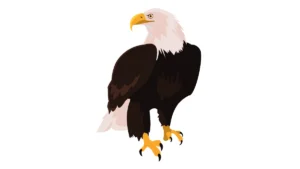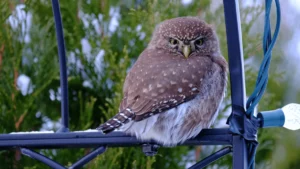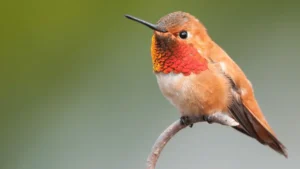Lots of different kinds of birds live in the Pacific Northwest. People who like to watch birds like going there.
Watching birds is a fun thing to do in the Pacific Northwest. It also helps take care of nature.
Scientists observed how many birds there are to know if the environment is healthy and to find places that need help. Also know about how birds mate!
Let’s start learning about our subject!
| TOP 9 MUST-SEE BIRDS OF THE PACIFIC NORTHWEST
THE BALD EAGLE

|
FACTS |
|
| SCIENTIFIC NAME | Haliaeetus leucocephalus |
| LIFESPAN | Up to 20-30 years in the wild |
| TOP SPEED | 40-70 miles per hour (64-113 km/h) |
| WEIGHT | 6.5-14 pounds (2.9-6.3 kilograms) |
| LENGTH | 28-40 inches (71-102 centimeters) |
| KINGDOM | Animalia |
| PHYLUM | Chordata |
| CLASS | Aves |
| ORDER | Accipitriformes |
| FAMILY | Accipitridae |
| GENUS | Haliaeetus |
| SPECIES | Haliaeetus leucocephalus |
| SOUND OF BALD EAGLE
The Bald Eagle: A Symbol of the Pacific Northwest, same as white pigeons and hummingbird eggs.
The Bald Eagle is a special bird in the Pacific Northwest. It’s considered a symbol of this place.
The bald eagle is a very famous bird in the Pacific Northwest. It is a strong independent bird with pretty white feathers on its head and tail.
The birds look for fish and other animals to eat near water.
Bald eagles love each other forever and make big homes in tall trees close to water.
Bald eagles are important to Native American culture and history in the Pacific Northwest.
People thought they were very special and magical. Artists and storytellers liked to show them in pictures and stories.
THE COLORFUL AND CHATTY STELLAR’S JAY

|
FACTS |
|
| SCIENTIFIC NAME | Cyanocitta stelleri |
| LIFESPAN | Up to 16-18 years in the wild |
| TOP SPEED | Average flight speed of 20-25 mph (32-40 km/h) |
| WEIGHT | 3.5-4.9 ounces (100-140 grams) |
| LENGTH | 11-12 inches (28-30 centimeters) |
| KINGDOM | Animalia |
| PHYLUM | Chordata |
| CLASS | Aves |
| ORDER | Passeriformes |
| FAMILY | Corvidae |
| GENUS | Cyanocitta |
| SPECIES | Cyanocitta stelleri |
| FACTS | Stellar’s Jay |
| SOUND OF STELLERS JAY
You can see Steller’s Jay a lot in the Pacific Northwest. It has pretty blue and black feathers and a cool crest on its head.
These birds speak a lot and are very loud. You can easily hear them before you see them.
Steller’s Jays are smart birds. They can also copy the sounds of other birds and people.
They can hide food for later eating. This is called caching, and they are good at it.
THE ELUSIVE NORTHERN PYGMY OWL

|
FACTS |
|
| SCIENTIFIC NAME | Glaucidium californicum |
| LIFESPAN | Up to 5-7 years in the wild |
| TOP SPEED | Average flight speed of 20-30 mph (32-48 km/h) |
| WEIGHT | 2.3-2.8 ounces (65-80 grams) |
| LENGTH | 6-7 inches (15-18 centimeters) |
| KINGDOM | Animalia |
| PHYLUM | Chordata |
| CLASS | Aves |
| ORDER | Strigiformes |
| FAMILY | Strigidae |
| GENUS | Glaucidium |
| SPECIES | Glaucidium californicum |
| FACTS | Northern Pygmy Owl |
| SOUND OF PYGMY OWL
The Northern Pygmy Owl is a tiny bird that is very strong. It can be hard to see in nature.
These birds are small. They are only 6 inches tall. They hide in tree bark.
They hunt well and eat little animals and birds.
The Northern Pygmy Owls make a special sound that sounds like a bunch of whistles.
You should definitely see a lot more small birds like the northern pygmy owl!
THE GRACEFUL GREAT BLUE HERON

|
FACTS |
|
| Scientific Name | Ardea herodias |
| Lifespan | Up to 15-20 years in the wild, can live longer in captivity |
| Top Speed | 20-30 miles per hour (32-48 km/h) |
| Weight | 4.5-7.9 pounds (2-3.6 kilograms) |
| Length | 3.2-4.5 feet (97-137 centimeters) |
| Kingdom | Animalia |
| Phylum | Chordata |
| Class | Aves |
| Order | Pelecaniformes |
| Family | Ardeidae |
| Genus | Ardea |
| Species | Ardea herodias |
| Facts | Great Blue Heron |
| SOUND OF BLUE HERON
The Great Blue Heron is an attractive bird. It loves to stand in shallow water to search for fish and other animals to eat.
These birds are big as well as have long, thin necks and legs.
They are good at hunting and like to sneak up on their food in the water.
Big grey birds called Great Blue Herons are very important in the Pacific Northwest. They help keep the fish healthy.
THE ENDANGERED MARBLED MURRELET

|
FACTS |
|
| SCIENTIFIC NAME | Brachyramphus marmoratus |
| LIFESPAN | Up to 20-30 years in the wild |
| TOP SPEED | Approximately 55 miles per hour (89 km/h) during flight |
| WEIGHT | 8-10 ounces (227-283 grams) |
| LENGTH | 8-10 inches (20-25 centimeters) |
| KINGDOM | Animalia |
| PHYLUM | Chordata |
| CLASS | Aves |
| ORDER | Charadriiformes |
| FAMILY | Alcidae |
| GENUS | Brachyramphus |
| SPECIES | Brachyramphus marmoratus |
| FACTS | Marbled Murrelet |
| SOUND OF MARBLED MURRELET
The Marbled Murrelet is a little bird that lives in the sea. It is in danger in the Pacific Northwest.
These birds lay their eggs on old trees’ branches, which is a special way of making their nests.
People need to help Marbled Murrelets because they only have a few homes left.
We can help them stay safe.
BLACK-CAPPED CHICKADEE

|
FACTS |
|
| SCIENTIFIC NAME | Poecile atricapillus |
| LIFESPAN | Up to 6-10 years in the wild |
| TOP SPEED | Approximately 20-25 miles per hour (32-40 km/h) |
| WEIGHT | 0.3-0.5 ounces (9-14 grams) |
| LENGTH | 4.7-5.9 inches (12-15 centimeters) |
| KINGDOM | Animalia |
| PHYLUM | Chordata |
| CLASS | Aves |
| ORDER | Passeriformes |
| FAMILY | Paridae |
| GENUS | Poecile |
| SPECIES | Poecile atricapillus |
| FACTS | Black-capped Chickadee |
| SOUND OF BLACK-CAPPED CHICKADEE
Birds of the Pacific northwest. The Black-capped Chickadee is a cute little bird that likes to explore and make friends.
Chickadees usually fly in trees and bushes to find bugs and seeds.
Black-capped Chickadees can easily create a special sound like “chick-a-dee-dee-dee.” People know them for this sound.
THE STRIKING WESTERN TANAGER

|
FACTS |
|
| SCIENTIFIC NAME | Piranga ludoviciana |
| LIFESPAN | Up to 6-8 years in the wild |
| TOP SPEED | Average flight speed of 20-25 mph (32-40 km/h) |
| WEIGHT | 0.9-1.1 ounces (25-31 grams) |
| LENGTH | 5.5-7 inches (14-18 centimeters) |
| KINGDOM | Animalia |
| PHYLUM | Chordata |
| CLASS | Aves |
| ORDER | Passeriformes |
| FAMILY | Cardinalidae |
| GENUS | Piranga |
| SPECIES | Piranga ludoviciana |
| FACTS | Striking Western Tanager |
| SOUND OF WESTERN TANAGER
You can see Birds of the Pacific Northwest an attractive bird called the Western Tanager in the summer in the Pacific Northwest. It has bright colors!
These birds are easy to spot in the trees because they have bright red heads and yellow bodies.
Western Tanagers eat bugs and fruit. They sit up high in trees a lot.
THE MIGRATORY RUFOUS HUMMINGBIRD

|
FACTS |
|
| SCIENTIFIC NAME | Selasphorus rufus |
| LIFESPAN | Up to 3-5 years in the wild |
| TOP SPEED | Average flight speed of 30-45 mph (48-72 km/h) |
| WEIGHT | 0.1-0.3 ounces (3-8 grams) |
| LENGTH | 2.8-4.3 inches (7-11 centimeters) |
| KINGDOM | Animalia |
| PHYLUM | Chordata |
| CLASS | Aves |
| ORDER | Apodiformes |
| FAMILY | Trochilidae |
| GENUS | Selasphorus |
| SPECIES | Selasphorus rufus |
| FACTS | Rufous Hummingbird |
| SOUND OF RUGOUS HUMMINGBIRD
A little bird called Rufous Hummingbird travels every year through the Pacific Northwest.
These birds are orange and can fly really fast and move around easily.
Rufous Hummingbirds drink nectar. They fly and stop near flowers to drink them.
THE RARE AND BEAUTIFUL HARLEQUIN DUCK

|
FACTS |
|
| SCIENTIFIC NAME | Selasphorus rufus |
| LIFESPAN | Up to 3-5 years in the wild |
| TOP SPEED | Average flight speed of 30-45 mph (48-72 km/h) |
| WEIGHT | 0.1-0.3 ounces (3-8 grams) |
| LENGTH | 2.8-4.3 inches (7-11 centimeters) |
| KINGDOM | Animalia |
| PHYLUM | Chordata |
| CLASS | Aves |
| ORDER | Apodiformes |
| FAMILY | Trochilidae |
| GENUS | Selasphorus |
| SPECIES | Selasphorus rufus |
| FACTS | Rufous Hummingbird |
| SOUND OF HARLEQUIN DUCK
Birds of the Pacific northwest. The Harlequin Duck is a very pretty and special duck that lives only in the Pacific Northwest.
These birds look pretty with their black and white feathers. They often hang out near rivers and streams that move fast.
Harlequin Ducks might disappear because their home is being destroyed. People are trying to help them stay safe.
| VIDEO OF BIRDS OF THE PACIFIC NORTHWEST
|
| CONCLUSION
Birds of the Pacific Northwest? There are numerous types of birds that live in the Pacific Northwest. All these birds have got some special things that make them different from each other.
The birds in this area are quite amazing! You can see big bald eagles and little Rufous Hummingbirds.
People in the Pacific Northwest love to watch birds. It helps them take care of the birds.
Scientists observe and write about birds to know how healthy the environment is and find places that need help.
